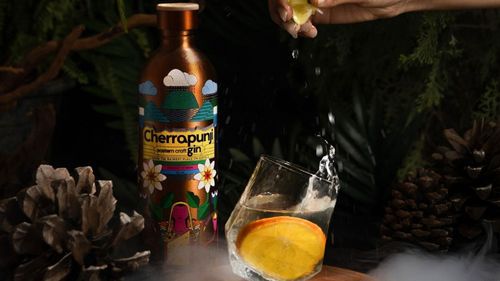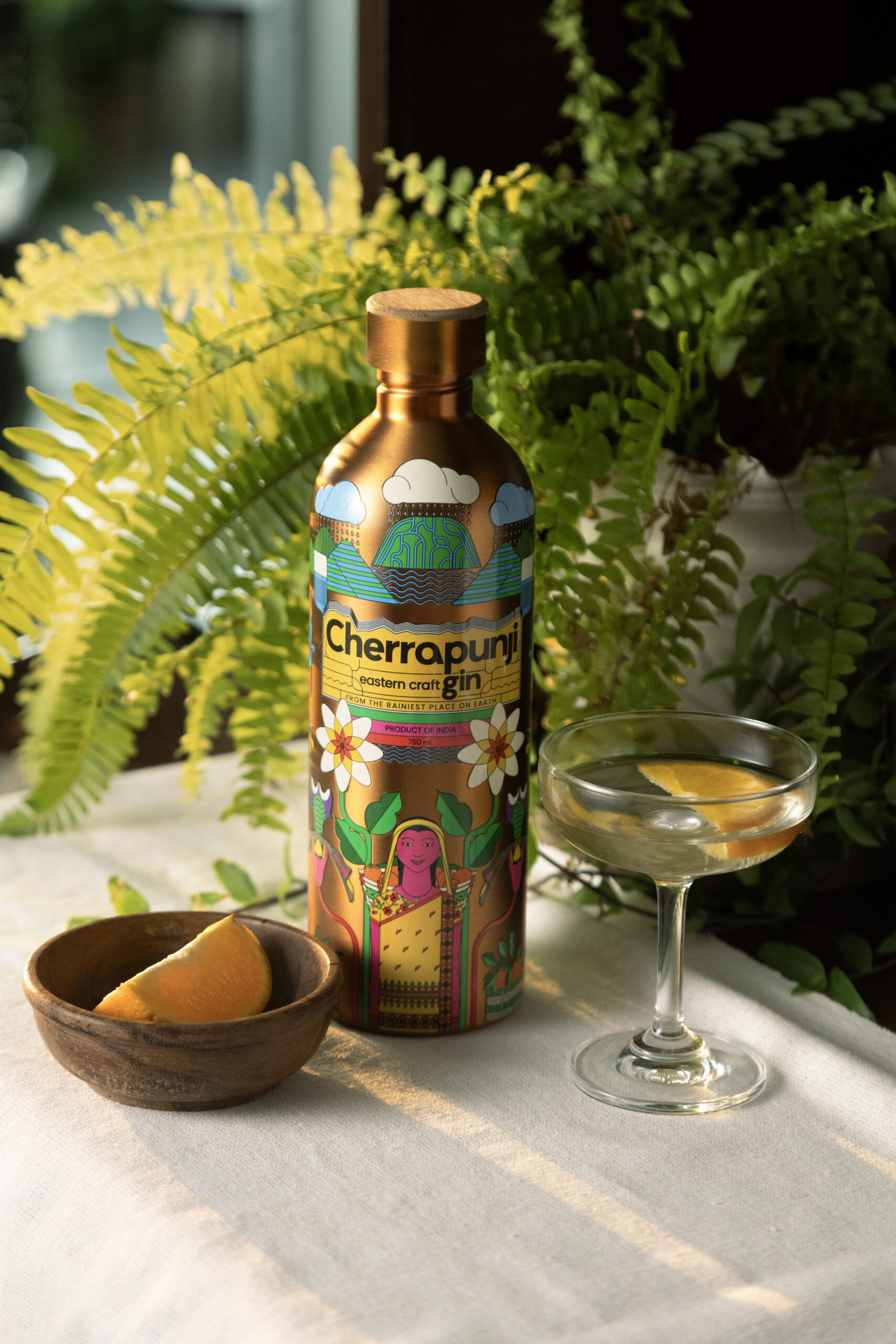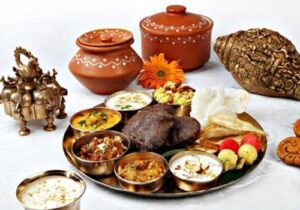Indian gin is no longer just an exotic novelty—it’s earned commercial success, won awards, attracted global spirits giants and created a vibrant ecosystem of distillers, bar culture and consumers. It’s crafting a distinct Indian identity in the global gin scene, marked by flavour experimentation, storytelling and cultural authenticity.
From a niche category, gin is becoming mainstream. The Indian gin market hit about US$635 M in 2024 and is projected to reach ~US$945 M by 2033, growing at ~4.2% CAGR. Meanwhile, local premium gin volumes have more than doubled since 2019 and may nearly triple by 2026. Cherrapunji Eastern Craft Gin is one of the brands that has made a mark in the Indian alcoholic beverages (alcobev) market. Founded in 2023 by Mr. Mayukh Hazarika, Cherrapunji Gin is crafted using naturally distilled rainwater harvested from Cherrapunji and Mawsynram—Earth’s rainiest spots. This sustainable choice also replaces chemically treated water commonly used in spirit production. Here is Mayukh sharing more about his Cherrapunji Eastern Craft Gin.

Why and how did you get into the alcoholic beverage business?
I saw a clear gap in the market for high-quality spirits that reflect the richness of the Northeast, not just in ingredients, but in story and origin. The idea wasn’t to chase trends but to build something with integrity and a strong sense of place. That’s what drew me to the alco-bev space. It felt like the right intersection of creativity, culture and long-term value.
What inspired the name Cherrapunji Gin? What’s the story behind it?
The name Cherrapunji Eastern Craft Gin draws its identity from Cherrapunji—also known as Sohra—one of the rainiest places on Earth, along with its sister village, Mawsynram. Most people remember studying about it in school or hearing about the astonishing amount of rainfall it receives. But the real inspiration wasn’t just the abundance of rain—it was the irony. Despite such heavy rainfall, these regions face severe water shortages in the winter. People often walk kilometres just to fetch water. That contradiction stayed with me. I didn’t want just to romanticise the rain; I wanted to build a mindful company—one that gives back more than it takes. So instead of using groundwater, we decided to use rainwater to make our gin. Not as a gimmick—but because it’s sustainable. It conserves energy, avoids unnecessary filtration processes and reflects a more respectful way of working with nature. There’s another layer to the name as well. Cherrapunji, for a brief period during British rule, was a colonial outpost. The British loved their cool, misty climate—comparing it to Scotland—but eventually found it too intense and shifted their base to Shillong. That colonial connection brings an unexpected twist to the story of gin. Gin is traditionally British, but Cherrapunji Gin isn’t a London Dry. It’s our own kind—it’s a Cherrapunji Wet. Something that reflects where it’s from, not where gin came from. So yes, the name is rooted in place, paradox and a promise—to craft something unique, with care and responsibility.

What makes Cherrapunji Gin stand out from other gins, particularly Indian gins?
Cherrapunji Gin is rare—not by design, but by origin. We didn’t set out to replicate any style or follow global gin trends. Instead, we let the land guide us. The Northeast offers an untapped botanical diversity unlike anywhere else. Our gin features two GI-tagged ingredients—Kaji Nemu from Assam and Khasi Mandarin from Cherrapunji—alongside wild Sohmarit pepper, smoked tea from the Lushai Hills and black cardamom from Sikkim. Even the base spirit is made from grain sourced in the Eastern Himalayas. Rainwater replaces groundwater, not as a novelty, but as a conscious choice. The result is a gin deeply rooted in place, offering a true taste of the region in every pour.
How does Cherrapunji Gin reflect India’s diverse ecology and cultural heritage?
While I’ve spoken about the native botanicals we use—like the GI-tagged Kaji Nemu from Assam and Khasi Mandarin from Cherrapunji—the way we’ve brought them together is just as important. Cherrapunji Gin doesn’t just taste different because of where it’s from, but because of how it reflects the food traditions and cultural memory of the region. The smoky finish, for example, is not an affectation—it is tradition distilled. In the Northeast, smoking food is an integral part of life, rooted in necessity, carried through generations. We wanted that to come through in the gin. So while it opens with bright citrus and a clean base, it ends with that gentle, unmistakable smokiness.
Our citrus is equally telling. Khasi Mandarin isn’t sharp or acidic—it’s vibrant, sweet and aromatic. Kaji Nemu brings a rounder, softer citrus note. These fruits grow on steep, rain-lashed slopes. Harvesting them means walking nearly an hour down into the valleys and back up again, baskets on heads, through the mist. That effort, that landscape—it lives in every sip. Even ingredients like the smoked cardamom from Sikkim are the result of age-old methods—smoked slowly over pinewood, turning them black, aromatic and unmistakably regional. So Cherrapunji Gin reflects India’s ecology in its ingredients—but it reflects its culture in how they’re grown, harvested and honoured.
Because Cherrapunji Gin is the only Indian gin that truly tastes like where it comes from.
How does Cherrapunji Gin pair with various cocktails and food?
Cherrapunji Gin works well across a wide spectrum—from refreshing G&Ts and Gimlets to smoky Negronis and spirit-forward drinks. Its balance of citrus and subtle smoke makes it versatile without losing its character. Food-wise, it complements anything with citrus, herbs or light smoke—whether it’s grilled vegetables, smoked eggplant, sushi or even regional Indian dishes like jackfruit kebabs or mustard-spiced greens. It pairs especially well with vegetarian and vegan cuisine that’s fresh yet layered. Personally, my favourite way to have it is something I call the Cherrapunji Gin Sonic. It’s 45 ml of our gin, mixed with equal parts tonic and soda. I prefer the Sepoy Elderflower Tonic in India and Fever Tree Mediterranean Tonic when abroad—always with good soda and lots of ice. Clean, crisp and it lets the gin speak.

What specific botanicals are used in Cherrapunji Gin and where are they sourced?
While I’ve already mentioned the key botanicals earlier, what matters just as much is our sourcing approach. Since the goal was to create a gin rooted in the Northeast, we’ve kept all our botanicals native to this region. Khasi Mandarin and Sohmarit pepper come from Meghalaya, Kaji Nemu from Assam, smoked tea from the Lushai Hills in Mizoram and smoked black cardamom from Sikkim. The juniper is sourced from the Eastern Himalayas—specifically Arunachal Pradesh and Sikkim. Instead of looking outward, we focused on what grows here, letting the region guide both the flavour and the spirit.
What is the distillation process for Cherrapunji Gin and where is it done?
Cherrapunji Gin is distilled in Meghalaya, close to Umiam Lake, using harvested rainwater from our facility and from Mawsynram—the wettest place on Earth. Using rainwater isn’t just symbolic; it’s a conscious decision to avoid groundwater and reduce our environmental footprint. We use a custom, energy-efficient still imported from Europe, designed to consume significantly less energy than traditional pot stills. The entire process is focused on preserving the integrity of our botanicals—Khasi Mandarin, Kaji Nemu, Sohmarit pepper, smoked tea and Himalayan juniper—while maintaining a smooth, clean spirit. It’s a process that blends precision with restraint—so the gin speaks of where it’s from, with nothing in excess.
Are there different varieties of Cherrapunji Gin?
Right now, we’re focused on our core expression — the Eastern Craft Gin.

In which markets is Cherrapunji Gin currently available? Are there any expansion plans?
Cherrapunji Gin is currently available in Meghalaya, Assam and Arunachal in the Northeast. We also export to select markets in the European Union and Southeast Asia. This summer, we’re expanding into Western and Northern India, with launches planned in key cities to strengthen our presence nationwide.
What’s the next exciting development for Cherrapunji Gin?
We’re exploring a few ideas — from limited-edition variants to experiences that bring people closer to the brand and the region. There are also conversations around expanding our presence both within India and internationally. Nothing is set in stone yet, but we’re focused on growing in a way that feels right for the brand and stays true to the idea of Eastern Craft.







